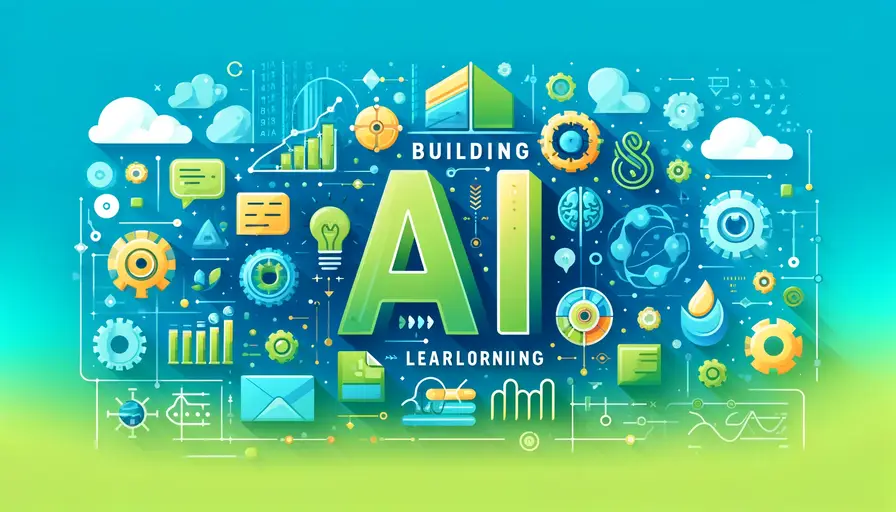
Building Machine Learning AI

- Understanding the Basics of Machine Learning and AI
- Choosing the Right Programming Language
- Gathering and Cleaning Data
- Selecting the Appropriate Algorithm
- Training Your AI Model
- Evaluating the Model
- Fine-Tuning and Optimization
- Deploying the AI Model
- Monitoring and Updating the Model
- Staying Updated with AI Advancements
Understanding the Basics of Machine Learning and AI
To build a successful machine learning AI, it is crucial to understand the basics of machine learning and artificial intelligence. This foundational knowledge will guide you through the entire process, from data collection to model deployment.
Key Components of Machine Learning AI
Machine learning AI consists of several key components, including data, algorithms, and models. Data serves as the foundation, providing the information needed to train the models. Algorithms process the data, identifying patterns and making predictions. Models are the final output of the machine learning process, used to make decisions or predictions based on new data.
Steps to Building Machine Learning AI
Building a machine learning AI involves a series of steps: understanding the problem, gathering data, choosing the right algorithm, training the model, evaluating performance, and deploying the model. Each step requires careful consideration and iteration to ensure the best possible results.
Importance of Fundamentals
Grasping the fundamentals of machine learning and AI helps in making informed decisions throughout the project. It enables you to select the appropriate tools, understand the limitations, and effectively troubleshoot issues that may arise.
 The Role of Abstract Algebra in Data Analysis for Machine Learning
The Role of Abstract Algebra in Data Analysis for Machine LearningChoosing the Right Programming Language
Selecting the right programming language is a crucial step in building your AI project. Different languages offer various advantages depending on the task at hand.
Popular Languages for AI
Python is the most popular language for machine learning and AI due to its simplicity, extensive libraries, and strong community support. Other languages like R, Java, and C++ also have their own strengths and can be chosen based on specific project requirements.
Criteria for Selection
When choosing a programming language, consider factors such as ease of use, library support, performance, and community support. Python, for instance, has libraries like TensorFlow, Keras, and scikit-learn, which are highly beneficial for machine learning tasks.
Example of Python for AI
Here's an example of a simple machine learning model using Python and scikit-learn:
 KNN Machine Learning in R: A Syntax Guide
KNN Machine Learning in R: A Syntax Guidefrom sklearn.datasets import load_iris
from sklearn.model_selection import train_test_split
from sklearn.ensemble import RandomForestClassifier
# Load data
iris = load_iris()
X = iris.data
y = iris.target
# Split data
X_train, X_test, y_train, y_test = train_test_split(X, y, test_size=0.2, random_state=42)
# Train model
model = RandomForestClassifier()
model.fit(X_train, y_train)
# Evaluate model
accuracy = model.score(X_test, y_test)
print(f'Accuracy: {accuracy}')Gathering and Cleaning Data
Gathering and cleaning data is essential for training your AI model. The quality of your data directly impacts the performance of your model.
Data Collection
Collect data from various sources relevant to your problem. This could include public datasets, company databases, APIs, or web scraping. Ensure that the data collected is representative of the problem you are trying to solve.
Data Cleaning
Data cleaning involves handling missing values, removing duplicates, correcting errors, and normalizing data formats. This step ensures that the data is consistent and ready for analysis. Clean data leads to more accurate and reliable machine learning models.
Example of Data Cleaning
Here's an example of data cleaning using Python and pandas:
 Bayesian Machine Learning for AB Testing with Python Techniques
Bayesian Machine Learning for AB Testing with Python Techniquesimport pandas as pd
# Sample data with missing values
data = {'feature1': [1, 2, None, 4], 'feature2': [4, None, 3, 1]}
df = pd.DataFrame(data)
# Fill missing values with mean
df.fillna(df.mean(), inplace=True)
print(df)Selecting the Appropriate Algorithm
Selecting the appropriate machine learning algorithm for your task is critical. The right algorithm depends on the nature of your data and the problem you are trying to solve.
Types of Machine Learning Algorithms
There are various types of machine learning algorithms, including supervised, unsupervised, and reinforcement learning. Supervised learning algorithms, like regression and classification, are used when the output is known. Unsupervised learning, such as clustering, is used when the output is not known. Reinforcement learning is used for decision-making problems.
Consider the Nature of Your Data
Choose an algorithm based on your data type and problem. For instance, decision trees and random forests are suitable for classification tasks, while linear regression is used for continuous data prediction. Understanding your data helps in selecting the most effective algorithm.
Experiment and Iterate
Experiment and iterate with different algorithms to find the best fit for your data. It is often beneficial to try multiple algorithms and compare their performance before finalizing one.
 Machine Learning vs AI: Understanding the Difference
Machine Learning vs AI: Understanding the DifferenceTraining Your AI Model
Training your AI model using the collected data is a crucial step in building an effective machine learning system.
Preparing the Data
Before training, ensure that your data is preprocessed correctly. This includes handling missing values, encoding categorical variables, and scaling numerical features. Properly prepared data leads to better model performance.
Model Training
Model training involves feeding the preprocessed data into the machine learning algorithm. The model learns from the data, identifying patterns and making predictions. This process requires dividing the data into training and validation sets to prevent overfitting.
Example of Model Training
Here's an example of training a machine learning model using Python and scikit-learn:
 Validity and Reliability of Unsupervised Machine Learning
Validity and Reliability of Unsupervised Machine Learningfrom sklearn.linear_model import LogisticRegression
# Sample data
X_train = [[1, 2], [3, 4], [5, 6]]
y_train = [0, 1, 0]
# Train model
model = LogisticRegression()
model.fit(X_train, y_train)
print(model.predict([[2, 3]]))Evaluating the Model
Evaluating the performance of your trained model is essential to understand its accuracy and effectiveness.
Model Evaluation Metrics
Common evaluation metrics include accuracy, precision, recall, and F1-score. These metrics help in assessing different aspects of model performance and understanding how well it generalizes to new data.
Cross-Validation
Cross-validation is a technique used to evaluate the model's performance by dividing the data into multiple subsets and training/testing the model on different combinations. This provides a more robust estimate of model performance.
Example of Model Evaluation
Here's an example of evaluating a machine learning model using Python and scikit-learn:
 Machine Learning in Advancing Natural Language Processing
Machine Learning in Advancing Natural Language Processingfrom sklearn.metrics import accuracy_score
# Sample data
X_test = [[2, 3], [4, 5]]
y_test = [0, 1]
# Model predictions
y_pred = model.predict(X_test)
# Evaluate model
accuracy = accuracy_score(y_test, y_pred)
print(f'Accuracy: {accuracy}')Fine-Tuning and Optimization
Fine-tuning and optimizing your AI model is necessary for achieving the best possible performance.
Hyperparameter Tuning
Hyperparameters are settings that control the learning process. Techniques like manual tuning, grid search, and random search can be used to find the optimal set of hyperparameters for your model.
Grid Search
Grid search involves specifying a set of possible values for each hyperparameter and evaluating the model for each combination. This systematic approach ensures that the best combination is found.
Bayesian Optimization
Bayesian optimization uses probabilistic models to select the most promising hyperparameter values. This method is more efficient than grid search and random search, finding the optimal set with fewer evaluations.
Example of Grid Search
Here's an example of using grid search for hyperparameter tuning using Python and scikit-learn:
from sklearn.model_selection import GridSearchCV
from sklearn.ensemble import RandomForestClassifier
# Sample data
X_train = [[1, 2], [3, 4], [5, 6]]
y_train = [0, 1, 0]
# Define model and parameters
model = RandomForestClassifier()
param_grid = {'n_estimators': [10, 50, 100], 'max_depth': [None, 10, 20]}
# Grid search
grid_search = GridSearchCV(model, param_grid, cv=3)
grid_search.fit(X_train, y_train)
print(grid_search.best_params_)Deploying the AI Model
Deploying your AI model in a production environment is the final step in the machine learning pipeline. This involves making the model available for use in real-world applications.
Choose the Deployment Platform
Selecting the right deployment platform is crucial. Options include cloud services like AWS, Google Cloud, and Azure, or on-premise servers. The choice depends on factors such as scalability, security, and cost.
Prepare the Model for Deployment
Before deployment, ensure that the model is optimized and packaged correctly. This might involve converting the model to a format suitable for deployment, such as ONNX or TensorFlow Serving.
Set Up the Environment
Setting up the deployment environment involves configuring servers, setting up APIs, and ensuring that the necessary dependencies are installed. This step ensures that the model can run efficiently in the production environment.
Example of Model Deployment
Here's an example of deploying a machine learning model using Flask in Python:
from flask import Flask, request, jsonify
import pickle
# Load model
model = pickle.load(open('model.pkl', 'rb'))
# Create Flask app
app = Flask(__name__)
# Define prediction endpoint
@app.route('/predict', methods=['POST'])
def predict():
data = request.get_json(force=True)
prediction = model.predict([data['features']])
return jsonify({'prediction': int(prediction[0])})
if __name__ == '__main__':
app.run(port=5000, debug=True)Monitoring and Updating the Model
Continuously monitoring and updating your AI model is essential to maintain its accuracy and performance over time.
Monitoring Model Performance
Monitoring model performance involves tracking key metrics such as accuracy, precision, and recall in real-time. This helps in detecting any decline in performance or changes in data distribution.
Updating the Model
Updating the model involves retraining it with new data or adjusting its parameters to improve performance. Regular updates ensure that the model remains accurate and relevant as new data becomes available.
Importance of Adaptation
Adapting to changing data patterns is crucial for the long-term success of the machine learning model. Regular updates ensure that the model remains effective in dynamic environments.
Staying Updated with AI Advancements
Staying updated with the latest advancements and research in the field of machine learning and AI is essential for continuous improvement.
Keeping Up with Research
Keeping up with research involves reading the latest papers, attending conferences, and participating in online courses. This helps in staying informed about new techniques, tools, and best practices.
Engaging with the Community
Engaging with the AI community through forums, meetups, and social media can provide valuable insights and foster collaboration. Sharing knowledge and experiences helps in advancing the field collectively.
Importance of Lifelong Learning
Lifelong learning is critical in the rapidly evolving field of AI. Continuously updating your skills and knowledge ensures that you remain competitive and capable of leveraging the latest advancements in your projects.
Building a machine learning AI involves a comprehensive process of understanding fundamentals, selecting appropriate tools, gathering and cleaning data, choosing the right algorithm, training and evaluating the model, deploying it in a production environment, and continuously monitoring and updating it. Staying updated with the latest advancements in AI ensures that your models remain accurate and effective, providing valuable insights and predictions for various applications. By following these steps meticulously, you can build robust and reliable machine learning AI systems.
If you want to read more articles similar to Building Machine Learning AI, you can visit the Artificial Intelligence category.






You Must Read